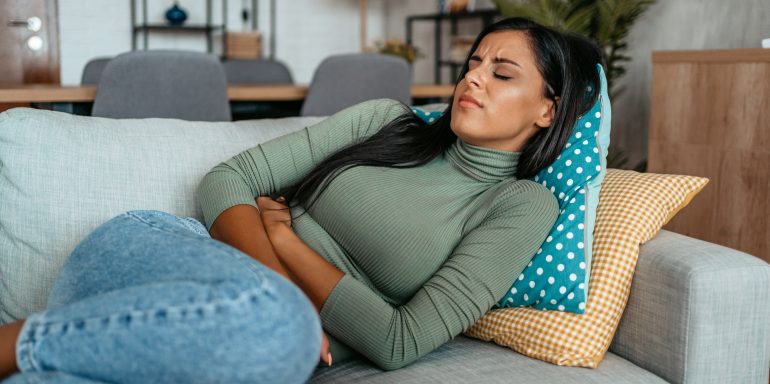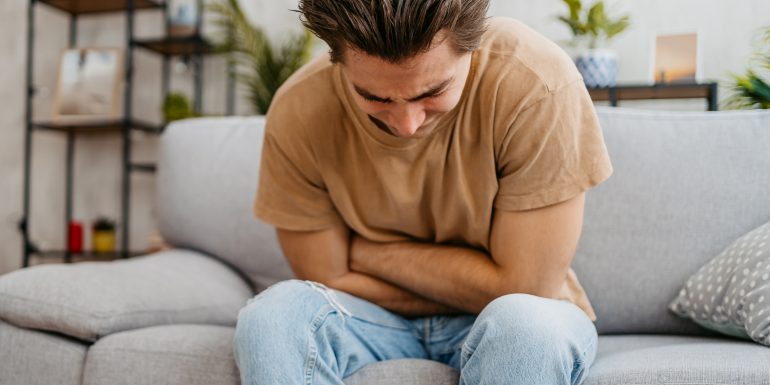
The menstrual cycle in simple terms
The menstrual cycle is controlled by various hormones. What exactly takes place? What characterises cycle phases 1 and 2? What happens during ovulation and the luteal phase? Learn all the facts about the menstrual cycle, its duration and phases.
What is the menstrual cycle?
The menstrual cycle is a perfectly designed plan to prepare the body for fertilisation. Every month, the uterus prepares itself for pregnancy.
At birth, female ovaries contain a total of around 500,000 to 2 million eggs. This decreases to around 300,000 to 400,000 by the time a girl reaches puberty. From puberty, five to fifteen of these eggs mature in each ovary every month in girls, although usually only one successfully ovulates.
During the course of a monthly cycle, the body’s cocktail of hormones changes continuously. It begins on the first day of menstruation, i.e. a woman’s period, and ends a day before the next period.
How long does a menstrual cycle last?
The average menstrual cycle lasts 28 days. But the length of the menstrual cycle varies from woman to woman – a cycle of anywhere from 25 to 31 days is considered normal. A long menstrual cycle (oligomenorrhea), however, lasts longer than 31 days, while a short menstrual cycle (polymenorrhea) lasts fewer than 24 days.
Variations in cycle lengths or irregular periods aren’t necessarily harmful or dangerous. But you should seek medical advice if you experience intense pain or heavy bleeding or if you are unable to conceive.
What are the phases of the menstrual cycle?
Cycle phase 1: menstruation – day 1 to 4
The menstrual cycle begins on the first day of menstruation. During this phase, the uterine lining which has built up is discharged. Menstrual blood is a mixture of this lining, mucus and some blood.
Good to know: resting phase
Your body is shedding in this phase and preparing for the cycle. This can use up a lot of your energy. In addition, this is often accompanied by period pains and bleeding. Give your body the time it needs in this phase of the menstrual cycle.
Cycle phase 2: follicular phase – day 5 to 14
During this phase, the pituitary gland releases a follicle-stimulating hormone, FSH for short. The follicles, meaning the egg cell surrounded by its accompanying cells, now mature in the ovaries, and the lining of the uterus builds up again. The oestrogen level rises in the follicular phase. The levels of the happy hormones serotonin and dopamine also rise. This makes many women experience high energy levels and feel particularly good about themselves during this phase of their cycle.
Good to know: the energy booster
In this phase of the menstrual cycle, your hormones are on your side: everything feels easier. The increasing oestrogen levels can even make you feel more attractive and help you to concentrate better.
Cycle phase 3: ovulation phase – day 14
The decrease in oestrogen levels and the rise in the LH and FSH hormones trigger ovulation. At this time, a follicle in one of the ovaries is usually fully mature and viable. The body then releases the egg into the fallopian tube. It is able to be fertilised there for approximately 12 to 24 hours. Under the influence of oestrogen, the cervical mucus becomes more fluid, enabling sperm cells to penetrate it better and reach the fallopian tubes. As the sperm can survive for up to five days in a woman’s body, the fertile window lasts approximately six days. The follicle’s cells transform into the corpus luteum which produces progesterone.
The fertile days usually begin three to five days before ovulation and last up to one day thereafter. A woman’s fertility level usually peaks on the 14th day of her cycle, i.e. the day of ovulation.
In a regular 28-day menstrual cycle, ovulation occurs on the 14th day of the cycle. To ensure your ovulation is calculated accurately, you need to know the first day of your last period. In order to calculate your menstrual cycle, we recommend noting down the first day of each of your periods for several months. Or you can determine the days you are fertile by using an ovulation test. Increased and thinner discharge is also an indication of fertile days. It facilitates the passage of sperm cells and extends their life.
Tip: use the ovulation calculator if you are planning a pregnancy. The calculator works out your fertile days. You can find these calculators on various websites. Menstrual cycle apps are also useful to track your period and ovulation.
Cycle phase 4: luteal phase – day 15 to 28
Under the influence of the luteinising hormone (LH), the embryonic membrane remaining in the ovary forms the corpus luteum. It maintains the level of progesterone for a period of time. The next development of the menstrual cycle phase depends on whether the egg is fertilised or not:
- The egg is not fertilised
The egg dies. The cervical mucus becomes thicker again. Simultaneously, the corpus luteum degenerates, progesterone production decreases, the uterine lining begins to disintegrate and is finally shed. Menstruation occurs – and a new cycle begins. - The egg is fertilised
The fertilised egg divides several times as it moves towards the uterus and implants in the uterine lining. The corpus luteum continues to produce progesterone. The placenta takes over the job of producing and supplying hormones during pregnancy. The next period never comes – and new life grows in the womb.
In the fourth phase of the menstrual cycle, many women are affected by low mood. This is one of the symptoms of premenstrual syndrome, or PMS for short. This symptom can occur in the second half of the cycle and usually goes away after menstruation begins.
Important: if you frequently have irregular periods, speak to your gynaecologist. This is also the person you should contact if you suffer from severe PMS.
In the luteal phase, the hormone progesterone will cause your appetite to increase significantly. Fruit, vegetables, fish, nuts and wholegrain products help to balance your hormones.
Which hormones play a role in the menstrual cycle?
Different hormones are involved in a woman’s cycle and control different processes:
Follicle-stimulating hormone (FSH)
This stimulates the production of oestrogen in the ovaries in women and sperm production in men.
Luteinising hormone (LH)
LH triggers ovulation in the middle of the cycle and aids production of the corpus luteum hormone.
Oestrogen
The female sex hormone is produced in the ovaries and, at lower levels, in fat tissue. Together with the other sex hormones, it controls several things including the maturation of egg cells. During menopause, oestrogen levels drop because the ovaries stop functioning. This often leads to disruptions in the menstrual cycle, hot flushes and vaginal dryness.
Progesterone
Progesterone, also called the corpus luteum hormone, changes the uterine lining, which has been prepared by oestrogen, so a fertilised egg can implant there. This hormone stimulates uterine growth and prepares the breasts for nursing. If pregnancy does not occur during a cycle, the progesterone level drops rapidly and the period begins. This can lead to disturbed sleep, bad moods, irritability and anxiety. The hormone is also used for contraception and for heavy menstrual bleeding.
Serotonin
The drop in the level of this hormone is partly responsible for mood swings. It particularly affects mood in the fourth phase of the menstrual cycle, as it often dips during this time. Its decrease also increases appetite.
Human chorionic gonadotropin (hCG)
hCG is produced by part of the placenta and sustains the pregnancy by prompting the corpus luteum to continue producing progesterone until the placenta takes over hormone production itself.
Our health advisors are happy to help you. They have specific tips on combating pain and how to improve your well-being.
Living in tune with your cycle
Living in tune with your menstrual cycle means having detailed knowledge of your cycle and its phases. The four phases of the menstrual cycle each have different features that can affect your body in positive and negative ways. Do you want to make the menstrual cycle work for you? Here’s what to do:
- First of all, keep a diary. Record your moods and physical condition in it.
- Look at your notes after a few months and see if you can detect any patterns. This will help you understand when and why you are feeling irritable, and in which phase you are likely to experience physical symptoms. Now you can adapt your exercise and relaxation more specifically to your needs.
- In the phase before and during menstruation, for example, you can adapt your exercise and sport routine to how you feel and perhaps also try out yoga, meditation and other methods of relaxation.
- In the first half of the cycle, on the other hand, you can generally be more active.
The menstrual cycle is a finely balanced process involving various hormones. It can run quite smoothly – but can also cause pain and mood swings. Make sure you seek medical advice and support if you suffer from these symptoms. Natural remedies are also available to help with the menstrual cycle and relieve discomfort.

Sabrina Stollberg is a specialist in general surgery recognised by the Swiss Medical Association (FMH) and a research associate in Helsana’s Public Health Sciences team. She provided the editorial team with advice and input for this article.


Newsletter
Find out more about current health issues every month and get all the information you need about our attractive offers from all Helsana Group companies * delivered by e-mail to read whenever it suits you. Our newsletter is free of charge and you can sign up here:
We did not receive your information. Please try again later.
* The Helsana Group comprises Helsana Insurance Company Ltd, Helsana Supplementary Insurances Ltd and Helsana Accidents Ltd.